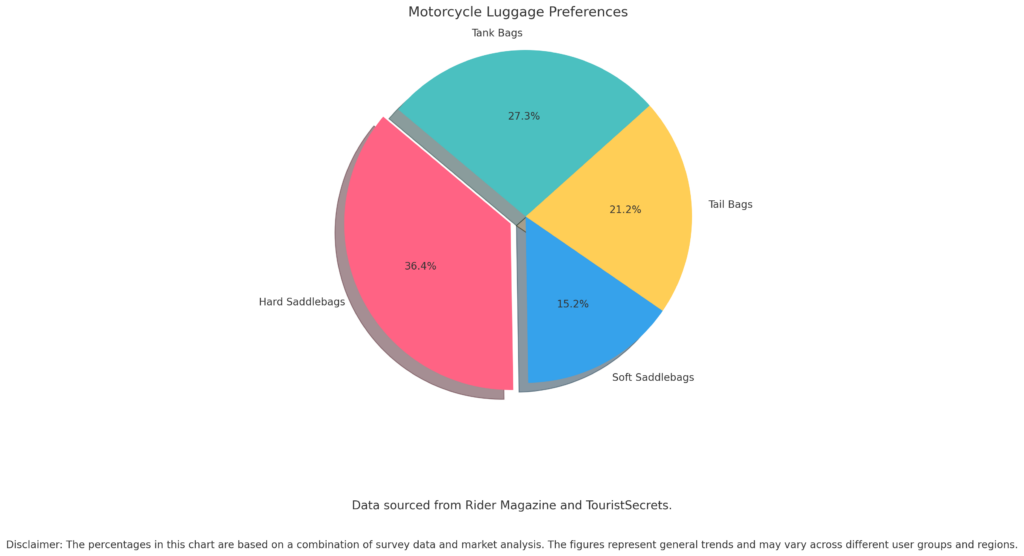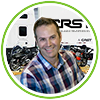Packing Like a Pro: Tips for Long-Distance Motorcycle Adventures

A long-distance motorcycle trip is like setting off on a two-wheeled safari—filled with excitement, surprises, and the occasional unexpected detour. But unlike a real safari, there’s no room for a team of porters to carry all your gear. Packing for a long ride can be challenging, requiring careful planning and consideration of things like comfort, safety, and convenience. Whether you are planning a road trip or a motocamping adventure, this guide provides essential tips for packing like a pro, from choosing the right luggage to optimizing space and securing your gear.
“Overpacking for a motorcycle trip is like bringing an umbrella to the desert—you’ll regret the extra baggage more than you miss the things you left behind.” Clement Salvadori – motorcycle journalist and travel writer
How to pack for a long trip on a motorcycle?
Choosing the Right Luggage
Selecting the appropriate luggage is a critical aspect of planning for a long motorcycle trip. The type of luggage you choose can significantly impact your journey’s comfort and convenience. There are several main options to consider, each with its advantages and specific use cases:
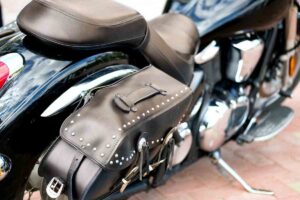
Tail bags are another versatile option, easily attaching to the rear cowling of the motorcycle. They are ideal for riders who are looking for extra storage space without significantly altering the bike’s handling characteristics. Tail bags can range from small packs suitable for day trips to larger ones capable of holding enough gear for extended journeys. A study by Motorcycle Consumer News revealed that 35% of long-distance riders use tail bags as supplementary storage, especially for items that are not frequently accessed.
Tank bags are mounted on the gas tank and are particularly useful for keeping essential items within easy reach. These bags are perfect for storing items like maps, phones, snacks, and other small necessities. They often come with transparent map pockets or compartments for electronic devices, allowing for easy navigation. Tank bags are usually secured with magnets or straps, making them easy to attach and detach. While they offer less storage space compared to saddlebags and tail bags, their convenience makes them a favorite among riders who frequently need to access their belongings. Around 45% of sport-touring motorcyclists opt for tank bags because of their convenience and ease of access.
Waterproofing and Durability
Regardless of the type of luggage chosen, making sure that it is waterproof and durable is crucial. Motorcycle trips often involve varying weather conditions, from sunny days to unexpected rain showers. Protecting your belongings from moisture is essential to avoid damage and ensure that everything remains in good condition.
Waterproof luggage is typically made from materials such as PVC, tarpaulin, or treated textiles. These materials provide a barrier against water, keeping the contents dry even during heavy rain. Many luggage options also feature sealed seams, waterproof zippers, and roll-top closures to further enhance their weather resistance.
Durability is another critical factor. The constant vibration and movement during a motorcycle trip can wear down luggage quickly. For this reason, it’s important to choose bags with reinforced stitching, heavy-duty zippers, and robust attachment points. Investing in high-quality, durable luggage may involve a higher upfront cost, but it pays off in the long run by providing reliable protection for your gear.
What is the best way to carry luggage on a motorcycle?
Balancing the Load
Proper weight distribution is crucial for maintaining your motorcycle’s balance, handling, and safety. An uneven load can significantly affect the bike’s dynamics, making it harder to control, especially during sharp turns, sudden stops, or adverse weather conditions. Here are key considerations for balancing your load effectively:
Packing Heavier Items Low and Centered
The heaviest items should be packed as low and close to the motorcycle’s center of gravity as possible. This typically means placing them in saddlebags close to the seat. Keeping the weight low helps maintain the bike’s stability by preventing it from becoming top-heavy. A top-heavy motorcycle can be hard to handle, especially when turning or dealing with strong crosswinds. Items like tools, spare parts, or heavier clothing should ideally be packed in the lowest compartments available.
Even Weight Distribution Side-to-Side
It’s equally important to ensure that weight is distributed evenly from side to side. Uneven weight distribution can cause the bike to lean to one side, making it difficult to steer straight and maintain balance. For example, if you have a heavy item on one side of the bike, try to balance it with a similarly weighted item on the opposite side. This principle is especially crucial for bikes with side panniers or saddlebags, where an imbalance can lead to uneven tire wear or even loss of control. Regularly check the balance by walking around the bike and ensuring it doesn’t lean unnaturally to one side.
Front-to-Back Balance
While it’s less common to affect the front-to-back balance significantly, it’s still essential to consider. You want to avoid placing too much weight on the back of the bike because it can lighten the front end and reduce traction on the front tire, making it more difficult to steer. Conversely, overloading the front can cause issues with braking and make the bike feel unstable. Try to distribute the load so the bike maintains its designed front-to-back balance for the best handling and safety.
Adjusting Suspension and Tire Pressure
Carrying additional weight on your motorcycle can require adjusting your bike’s suspension and tire pressure to accommodate the load. Many motorcycles come with adjustable suspension settings, allowing you to increase the preload to handle extra weight. Check your bike’s manual for the recommended settings based on your total load. In addition, slightly increasing the tire pressure can help manage the added weight and maintain proper contact with the road, improving both handling and tire longevity.
Utilizing Space Efficiently
Efficient use of space is just as important as balancing the load. Maximizing your luggage space not only helps in carrying more essentials but also ensures that items are stored securely and are easily accessible.
Packing Cubes and Compression Bags
Packing cubes and compression bags are excellent tools for organizing and minimizing the volume of your items. Packing cubes help segment your belongings, making it easier to find things without unpacking your luggage. Compression bags are good at reducing the bulk of soft items like clothing and sleeping bags, letting you fit more into your luggage.
Rolling Clothes
Rolling clothes instead of folding them is a proven space-saving technique. It reduces wrinkles and allows you to fit more clothing into a smaller space. This helps in tight storage areas like saddlebags or tank bags.
Utilizing Gaps and Small Spaces
Don’t overlook the small spaces and gaps between larger items. These areas are perfect for storing smaller items like socks, gloves, or toiletries. Filling these spaces efficiently prevents items from shifting during the ride and maximizes your packing capacity. Consider using zip-lock bags or small pouches to keep these items organized and protected.
You can significantly improve your motorcycle’s handling and safety by carefully balancing your load and utilizing your luggage space efficiently. A well-balanced and packed bike offers more comfort and control and makes for a more enjoyable and stress-free journey.
Where should you pack heavier items on a motorcycle?
Using Luggage Racks
Luggage racks are essential accessories for motorcyclists planning long trips, offering additional space and versatility for carrying gear. A luggage rack can significantly add to your bike’s storage capacity, providing a sturdy platform for securing various types of luggage, including saddlebags, tail bags, and even larger items like duffel bags or camping gear.
Types of Luggage Racks
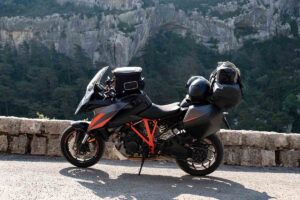
Benefits of Luggage Racks
The primary benefit of using luggage racks is the increased carrying capacity. They allow you to bring along more gear without overloading any single part of the motorcycle. This is particularly useful for long trips where you might need to carry extra things.
Another advantage of luggage racks is their ability to accommodate a wide range of luggage types and sizes. Many racks come with universal mounting systems, allowing you to use different bags and cases depending on your needs. This flexibility is particularly beneficial for riders who frequently change their travel setup based on the trip’s length and purpose.
Choosing the Right Luggage Rack
When selecting a luggage rack, consider the type of trips you plan to go on. Look for racks made from durable materials, such as stainless steel or aluminum, which can handle long-distance travel. Be sure that the rack is compatible with your motorcycle and can support the weight of your luggage without compromising safety.
How to strap a bag to the back of a motorcycle?
Securing Your Luggage
Properly securing your luggage is crucial to prevent it from shifting or falling off during the ride, which can pose significant safety risks. Incidents involving poor use of tie-downs, like those detailed in this tale of two motorcycle tie-down failures, highlight the importance of using the right securing methods. Various types of straps and securing methods can be used, depending on the type and size of the luggage. Here’s an overview of the most effective options:
Bungee Cords
Bungee cords are a popular choice for securing luggage due to their flexibility and ease of use. They come in various lengths and can stretch to accommodate different sizes of bags. Bungee cords are ideal for lighter loads and can be quickly attached and detached. However, it’s important to ensure they are in good condition, as worn or overstretched cords can snap. Using multiple bungee cords can provide additional security and distribute the tension more evenly.
Ratcheting Straps
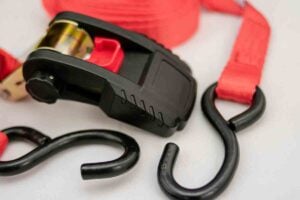
Ratcheting straps, or ratchet straps, provide a secure and adjustable way to fasten luggage. They consist of a strap and a ratchet mechanism that tightens the strap with a lever. Ratcheting straps are highly durable and can securely hold heavier loads than bungee cords. They are especially useful for securing hard luggage or large items like duffel bags. For detailed guidance on using these straps effectively, refer to the tips outlined in this guide on getting tied down properly. When using ratchet straps, ensure the excess strap is properly tucked away to avoid it flapping or getting caught in the bike’s moving parts.
Cam Buckle Straps
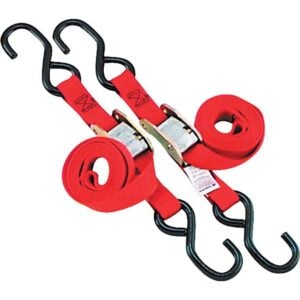
Cam buckle straps are another reliable option, similar to ratcheting straps but with a simpler mechanism. They use a cam buckle to adjust and tighten the strap. While not as heavy-duty as ratcheting straps, cam buckle straps are still strong and easier to adjust. They are a good choice for securing medium-weight luggage and are less likely to over-tighten, which can be a concern with ratcheting straps.
Cargo Nets
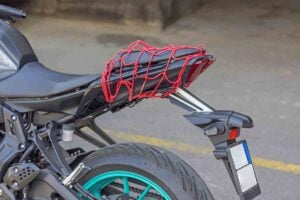
Cargo nets are flexible nets made of interwoven elastic cords. They are useful for holding irregularly shaped items or for securing multiple smaller items together. Cargo nets can easily stretch over the top of luggage and attach to the bike with hooks. They provide a versatile option for securing gear and can be used in conjunction with other straps for added security. However, it’s important to check that the hooks are secure and that the net is not too loose.
Securing Tail Bags and Saddlebags

For tail bags and saddlebags, many come with their own integrated attachment systems, such as straps or quick-release buckles. It’s essential to follow the manufacturer’s instructions for securing these bags, as improper attachment can lead to instability. Additionally, for bags with locks, ensure they are locked to prevent theft and unintentional opening during the ride.
Double-Checking Attachments
Before setting off, double-check all straps, cords, and nets to ensure they are tightly fastened and secure. Give the luggage a firm shake to confirm it won’t shift or come loose. It’s a good practice to periodically check the security of your luggage during stops, especially after riding on rough terrain or at high speeds.
Avoiding Overpacking
Overloading your motorcycle can adversely affect its handling and increase the risk of accidents. It’s crucial to stick to a well-thought-out packing list and avoid bringing unnecessary items. Packing light not only improves safety but also enhances the overall riding experience by making the bike easier to maneuver. Additionally, leaving some space in your luggage allows room for souvenirs or items you may acquire along the way.
Where do you put your backpack on a motorcycle?
Using a Motorcycle-Specific Backpack
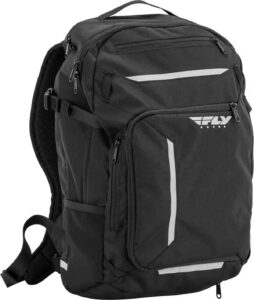
Motorcycle-specific backpacks are designed with riders in mind, offering features that enhance comfort and functionality during rides. These backpacks often come with ergonomically shaped shoulder straps and padded back panels, reducing discomfort and strain on long trips. They are also typically made from durable, weather-resistant materials to protect contents from the elements.
When wearing a motorcycle-specific backpack, it’s important to keep the load light and limited to essential or frequently accessed items. This approach minimizes strain on your back and shoulders and ensures you can ride comfortably for extended periods. These backpacks often include secure chest and waist straps that prevent shifting and help distribute the weight evenly across your torso, reducing fatigue.
Additionally, many motorcycle-specific backpacks feature reflective elements for increased visibility and safety during nighttime rides. Some even have built-in hydration systems, allowing you to stay hydrated without stopping.
Alternative Storage Options
If wearing a backpack becomes uncomfortable, or if you prefer not to wear one, there are other effective ways to carry it on your motorcycle. One option is to secure the backpack on the back seat or a luggage rack using straps, bungee cords, or a cargo net. This setup keeps the backpack secure and accessible, without compromising your comfort or mobility.
When securing a backpack to your motorcycle, ensure it is firmly attached to prevent movement during the ride. Use high-quality straps or bungee cords that can handle the weight and stress of the journey. It’s also important to evenly distribute the weight and avoid overloading the back, which could affect the bike’s balance and handling.
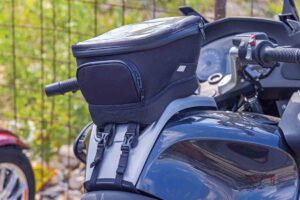
For valuable items or items you need quick access to, consider using a tank bag or another secure compartment. Tank bags are conveniently placed on the gas tank, making it easy to reach essential items like your phone, wallet, or navigation tools. They often feature additional security features, such as locking zippers or clips, to keep your belongings safe.
Final Thoughts on Packing for Your Motorcycle Journey
Packing efficiently for a long-distance motorcycle adventure requires thoughtful planning and smart packing strategies. By choosing the right luggage, prioritizing essential items, and ensuring proper weight distribution, you can enhance your riding experience and stay safe on the road. Remember, packing smart means packing light—focus on essentials and enjoy the freedom of the open road. For a hassle-free journey, consider getting a quote for motorcycle shipping services with motorcycleshippers.com. Safe travels!
It Takes Just Seconds to Get a Quote
See our Instant Quote Form and Get A Quote Now
More Great Resources from our Team to You.
CHECKLIST FOR BUYING A USED MOTORCYCLE
SHOULD YOU TRUST CONSUMER REPORTS MOTORCYCLE RELIABILITY STUDY?
HOW TO FIND CHEAP MOTORCYCLE TRANSPORT (AND AVOID HIDDEN COSTS)
HOW TO TRANSPORT A MOTORCYCLE | GUIDE WITH COST
Posted By
Clint Lawrence, founder of Motorcycle Shippers. Helping give riders more freedom to enjoy the bikes they love.
